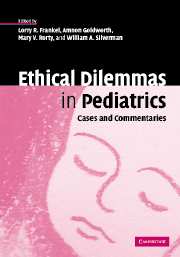Book contents
- Frontmatter
- Contents
- List of contributors
- Preface
- Introduction
- Part I Therapeutic misalliances
- Part II Medical futility
- Part III Life by any means
- Part IV Institutional impediments to ethical action
- 10.1 Ethical problems encountered with oncology and bone marrow transplant patients
- 10.2 Ethics in the pediatric intensive care unit: oncology and bone marrow transplant patients
- 10.3 Topical discussion
- 11.1 Nursing perspectives on withholding food and fluids in pediatrics
- 11.2 Ethics and clinical decision making: withholding food and information
- 11.3 Topical discussion
- 12.1 Ethics and managed care
- 12.2 Challenging fidelity: the physician's role in rationing
- 12.3 Topical discussion
- References
- Index
- References
10.1 - Ethical problems encountered with oncology and bone marrow transplant patients
Published online by Cambridge University Press: 18 August 2009
- Frontmatter
- Contents
- List of contributors
- Preface
- Introduction
- Part I Therapeutic misalliances
- Part II Medical futility
- Part III Life by any means
- Part IV Institutional impediments to ethical action
- 10.1 Ethical problems encountered with oncology and bone marrow transplant patients
- 10.2 Ethics in the pediatric intensive care unit: oncology and bone marrow transplant patients
- 10.3 Topical discussion
- 11.1 Nursing perspectives on withholding food and fluids in pediatrics
- 11.2 Ethics and clinical decision making: withholding food and information
- 11.3 Topical discussion
- 12.1 Ethics and managed care
- 12.2 Challenging fidelity: the physician's role in rationing
- 12.3 Topical discussion
- References
- Index
- References
Summary
Introduction
In an attempt to inform the reader of the ethical problems encountered in the pediatric intensive care unit with the care of oncology and bone marrow transplant patients, we present two cases, one of leukemia and the other of Hodgkin's lymphoma. The issues which these cases raise are complex, as they involve medical input from multiple services, concerns about communication and informed consent, the initiation of aggressive therapies with limited benefit, and decision-making power.
The first case involves a nine-year-old girl with acute lymphoblastic leukemia (ALL) who developed respiratory failure and Candida sepsis. The second case involves a 16-year-old female with Hodgkin's disease who underwent a bone marrow transplant (BMT) and then sustained complications in the post-transplant period.
The two cases
Multisystem organ failure and acute lymphoblastic leukemia
AD was a nine-year-old Latina who developed respiratory failure soon after her chemotherapy for relapsed lymphoblastic leukemia. She was first diagnosed with leukemia in Central America at the age of four. After the girl received an incomplete course of therapy, her mother brought her to the United States in hopes of receiving adequate treatment. She was treated into remission within a few months, but two years later the recurrence of her cancer was discovered on routine screening examination of her cerebrospinal fluid.
Re-induction therapy was begun, consisting of four intravenous chemotherapeutic agents as well as three medications delivered into the cerebrospinal fluid.
- Type
- Chapter
- Information
- Ethical Dilemmas in PediatricsCases and Commentaries, pp. 221 - 228Publisher: Cambridge University PressPrint publication year: 2005



